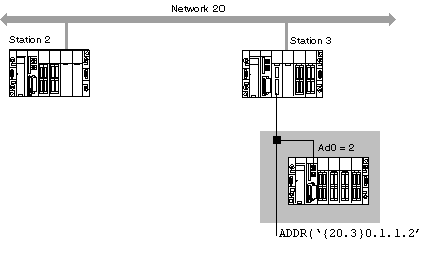X-Way addressing makes it possible to identify a communication entity on a network or a bus, or on a stationís bus on a network. Each station is identified by a unique address, which consists of a network number and a station number. The addresses then differ according to the bus:
-
Uni-Telway or Modbus bus
-
Fipio bus
Within a station, each communication entity is characterized by a topological address (access path) and a
type.
NOTE: An address is expressed in the form of a character string. However, it can only be used in conjunction with the function ADDR(), which is why the following notation will be used to describe an address: ADDR('address string');
Addressing a Station on a Network
The address of a station on a network takes the form: ADDR('{n.s}SYS')
where:
n: network number (network)
s: station number (station
Addressing a Device on a Uni-Telway or Modbus Bus
The address of a device on a Uni-Telway or Modbus bus depends on the station managing the bus:
where:
n: network number (network)
s: station number (station)
r: rack number (rack)
m: module number (module)
c: channel number (channel)
e: number of device or slave (equipment)
Addressing of a Device on a Fipio Bus
The address of a device on a Fipio bus depends on the station managing the bus:
where:
n: network number (network)
s: station number (station)
b: bus number (bus), for Fipio the bus number is always 2
e: device number (equipment)
The figure below describes the address of the station located in the gray rectangle. The example here shows slave 2 on channel 1 of the module in rack 0 (base rack), slot 1, on network 20, station 3:
